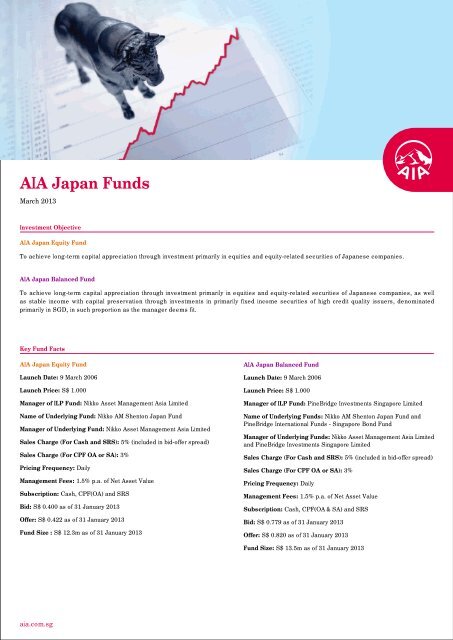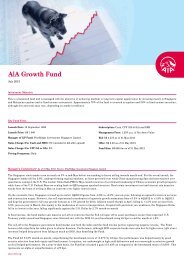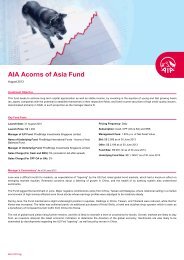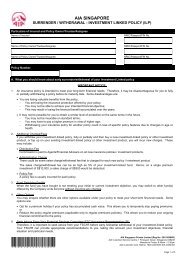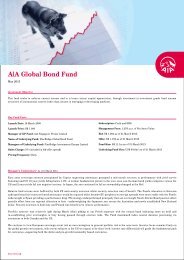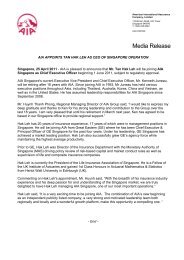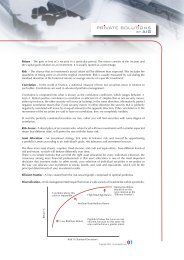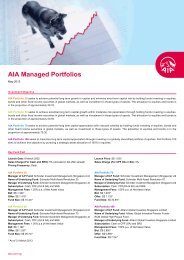You also want an ePaper? Increase the reach of your titles
YUMPU automatically turns print PDFs into web optimized ePapers that Google loves.
<strong>AIA</strong> <strong>Japan</strong> <strong>Funds</strong>March 2013Investment Objective<strong>AIA</strong> <strong>Japan</strong> Equity FundTo achieve long-term capital appreciation through investment primarily in equities and equity-related securities of <strong>Japan</strong>ese companies.<strong>AIA</strong> <strong>Japan</strong> Balanced FundTo achieve long-term capital appreciation through investment primarily in equities and equity-related securities of <strong>Japan</strong>ese companies, as wellas stable income with capital preservation through investments in primarily fixed income securities of high credit quality issuers, denominatedprimarily in SGD, in such proportion as the manager deems fit.Key Fund Facts<strong>AIA</strong> <strong>Japan</strong> Equity FundLaunch Date: 9 March 2006Launch Price: S$ 1.000Manager of ILP Fund: Nikko Asset Management Asia LimitedName of Underlying Fund: Nikko AM Shenton <strong>Japan</strong> FundManager of Underlying Fund: Nikko Asset Management Asia LimitedSales Charge (For Cash and SRS): 5% (included in bid-offer spread)Sales Charge (For CPF OA or SA): 3%Pricing Frequency: DailyManagement Fees: 1.5% p.a. of Net Asset ValueSubscription: Cash, CPF(OA) and SRSBid: S$ 0.400 as of 31 January 2013Offer: S$ 0.422 as of 31 January 2013Fund Size : S$ 12.3m as of 31 January 2013<strong>AIA</strong> <strong>Japan</strong> Balanced FundLaunch Date: 9 March 2006Launch Price: S$ 1.000Manager of ILP Fund: PineBridge Investments <strong>Singapore</strong> LimitedName of Underlying <strong>Funds</strong>: Nikko AM Shenton <strong>Japan</strong> Fund andPineBridge International <strong>Funds</strong> - <strong>Singapore</strong> Bond FundManager of Underlying <strong>Funds</strong>: Nikko Asset Management Asia Limitedand PineBridge Investments <strong>Singapore</strong> LimitedSales Charge (For Cash and SRS): 5% (included in bid-offer spread)Sales Charge (For CPF OA or SA): 3%Pricing Frequency: DailyManagement Fees: 1.5% p.a. of Net Asset ValueSubscription: Cash, CPF(OA & SA) and SRSBid: S$ 0.779 as of 31 January 2013Offer: S$ 0.820 as of 31 January 2013Fund Size: S$ 13.5m as of 31 January 2013aia.com.sg
<strong>AIA</strong> <strong>Japan</strong> <strong>Funds</strong> 2Manager’s Commentary* As of 31 January 2013The Nikko AM Shenton <strong>Japan</strong> Fund's unit price advanced 4.01%* in the month, resulting in a 0.40% underperformance against the benchmark in January.From a sector perspective, negative contributions from our overweight positions in Glass & Ceramics Product and Real Estate outweighed positivecontributions from our overweight in Transport Equipment. In terms of stock selection, Mazda Motor, a midsize automaker, Sony Corp., a consumerelectronicsmaker, and Avex Group Holdings, which produces, markets, and sells music CDs, videos and DVDs, were among major positive contributors.Meanwhile, electric power companies such as Hokkaido Electric Power Company and Tohoku Electric Power Company, and Orix Corp., a financial company,contributed negatively.During the month, we maintained the fund's basic characteristics. Currently we are overweight in Transport Equipment, Electrical Appliances and RealEstate while being underweight in Services, Land Transportation and Precision Instruments. In January, we increased our weight in wholesale trade toalmost neutral by purchasing Hanwa Corp., a trading company specializing in steel products. Also, we accumulated weight in banks by adding MizuhoFinancial Group and Fukuoka Financial Group. On the other hand, we decreased the degree of our overweight in transport equipment, real estate and otherfinancing business by locking in some profit for Mazda Motor, Tokyo Tatemono and Orix Corp., respectively, although we remain overweight these sectors.Market ReviewThe market rose in January as a global rally prompted investors to be less risk averse, and as the yen depreciated on speculation that the Bank of <strong>Japan</strong>(BOJ) would adopt monetary easing measures. The Nikkei 225 Stock Average ended the month at 11,138.66 (up 7.15% m/m) and TOPIX at 940.25 (up9.36%). Early in the month, the market rallied after the US avoided a potential near-term crisis related to the fiscal cliff, and as expectations increased foradditional monetary easing and anti-deflationary measures. The rally continued on improvement in US and Chinese economic indicators and on speculationthat the BOJ would opt for additional monetary easing at its monetary policy meeting. Stocks that advanced were those likely to benefit from the government'seconomic policies, those whose earnings are expected to improve on yen depreciation, and those that have released robust earnings results. TOPIX closedabove 900 on 15 January, while the Nikkei 225 recovered to above 11,000. Due in part to the relaxation of margin trading regulations which enabled anunlimited number of transactions per day from January, trading by individuals was buoyant and net unrealized gains/losses on margin positions turnedpositive for the first time in seven years.Market Outlook & Strategy**Following the strong rally in December, the Tokyo market continued to advance on positive developments overseas and at home. In the US, progress onthe fiscal cliff talks and benign macro economic data lifted the New York market to the highest levels in more than five years. Economic indicators in Chinasuggested the world's second largest economy hit the bottom in July to September 2012. The <strong>Japan</strong>ese yen depreciated below 90 yen/dollar and 120yen/euro levels on the back of the prospect of more aggressive monetary easing, recovery in global economies, and increased investor risk tolerance.In January, the TOPIX index advanced by 9.4% in <strong>Japan</strong>ese yen terms, whereas the US dollar-denominated MSCI <strong>Japan</strong> net total return index gained3.7% as the yen depreciated from mid 80s yen/US dollar levels to below 90s yen/US dollar levels. We remain positive on the Tokyo market as recovery inthe global economy led by the US and China will support the <strong>Japan</strong>ese economy, and domestic political and economic conditions will improve furtherbecause of the positive impact of "Abenomics" on <strong>Japan</strong>'s economy and corporate profit.Below, we update several key factors for the <strong>Japan</strong>ese equity market including (1) "Abenomics"; (2) corporate earnings and (3) supply and demand in theequity market;(1) Abenomics: Economic policies under the Abe cabinet to exit from deflation and to spur economic growth.The Abe cabinet is swiftly pursuing economic policy, or "Abenomics," with three pillars in order to end the vicious cycle between yen appreciation anddeflation. The three pillars are 1) bold monetary easing, 2) large fiscal spending and 3) growth strategy. The first two pillars have begun and alreadyhad a positive impact on the <strong>Japan</strong>ese economy. As for monetary easing, the BOJ introduced a 2% "Price Stability Target" and an "Open-Ended AssetPurchasing Method". The next BOJ Governor will be announced in February. Going forward, the yen will be driven by the US economy and risk toleranceof global investors. On fiscal policy, the Cabinet of PM Abe approved a 13.1 trillion yen supplementary budget, the second biggest ever of its kind, tofund an economic stimulus package. Discussion on the long-term fiscal discipline of <strong>Japan</strong> will start at government panel. We believe the third pillar, orgrowth strategy, is the most important to establish sustainable economic growth. The government has set up organizations to draw blueprints of policiesto tackle <strong>Japan</strong>'s structural issues. Issues such as tax reform including corporate tax cuts, regulation reform, and negotiations on the adoption of freetrade agreements such as the Trans Pacific Strategic Partnership (TPP) will be discussed at these organizations. To implement such economic policies,PM Abe needs to a win a majority in the upper house in the election next summer. For the Tokyo market, the approval rating of PM Abe's cabinet willbe the key for the next several months. So far, the new cabinet is doing a good job. According to a Nikkei Inc. and TV Tokyo Corp. poll, the approvalrating of PM Abe's cabinet rose to 68% from 62% at the end of last year, when Mr. Abe formed his cabinet. A rise in approval rating one month afterthe formation of government was the first time since 2001 under PM Koizumi's cabinet.(2) Corporate Earnings: Downward earnings revisions to end and upside potential for FY2013 earnings outlook.The earnings announcement season for the October to December 2012 quarter has peaked. As widely expected, manufacturers revised down theirearnings guidance for FY2012, or the year ending March 2013, due to sluggish global demand. The reaction by market participants was encouragingas we saw stock price advances for companies which revised down their guidance such as Komatsu and Honda Motor. The focus of market participantsis shifting to earnings in FY2013, or the year ending March 2014. Currently, aggregated recurring profit is expected to grow by 22% according to anaggregated forecast by Toyo Keizai. We believe as the global economy recovers and the yen stabilizes around current levels, large upside exists forFY2013 earnings. In mid term, a gradual yen depreciation trend, lower corporate tax rate and increase in shareholders' return will lead to a sharp recoveryin Earnings per Share (EPS) and high Return on Equity (ROE).
<strong>AIA</strong> <strong>Japan</strong> <strong>Funds</strong> 3(3) Supply and Demand of the Equity Market: Large potential for retail investors to become aggressive buyers of <strong>Japan</strong>ese equity.As the market advances, the activity of retail investors has started to pick up. In the TSE 1st Section, individual investors accounted for 30% of tradingvolume, up from less than 19% in October. <strong>Japan</strong>’s emerging market also became active recently. While the TOPIX index advanced 9% during the monthof January, the Tokyo Stock Exchange (TSE) Mothers (the market of high-growth and emerging stocks) index rose about 30% in January. Retail investorsaccounted for 80% of trading on Mothers. Retail investors and investment trusts continued to see a net outflow in December. In our experience, foreigninvestors are active net buyers while domestic investors are net sellers during the early stage of bull markets. Then, as the economy improves and shareprices continue to rise, investment trusts shift to a net purchase in <strong>Japan</strong>ese stocks. Individual investors aggressively buy shares on margin in bullmarkets. The total balance of long margin positions peaked at 5.98 trillion yen in February 2006 (for reference, the total balance of long margin positionsas at January 25 2013 was 1.46 trillion yen). We expect <strong>Japan</strong>’s retail investors to become buyers as market remains upbeat. Looking ahead, we continueto overweight cyclical stocks including transport equipment and electrical appliances as we maintain our positive view on the <strong>Japan</strong>ese economy underthe new cabinet as we have discussed above. We continue to underweight pharmaceutical stocks and consumer staple stocks. Regarding stock selection,we are focusing on the beneficiaries from the bull market in <strong>Japan</strong>ese equities such as banks and securities, and beneficiaries of yen depreciationincluding cross currency rates such as yen-won and yen-euro movement.Looking ahead, we continue to overweight cyclical stocks including transport equipment and electrical appliances as we maintain our positive view on the<strong>Japan</strong>ese economy under the new cabinet. We continue to underweight pharmaceutical stocks and consumer staple stocks. Regarding stock selection,we will focus on the beneficiaries of the rally in <strong>Japan</strong>ese equities such as banks and securities, and beneficiaries of yen depreciation including crosscurrency rates such as yen-won and yen-euro movements.* Data Source: (c)2013 Morningstar, Inc., as of end January 2013. The Fund's returns are on SGD, NAV-NAV basis with dividends anddistributions re-invested, if any.** Content Source: Daiwa SB Investments Ltd, January 2013.
<strong>AIA</strong> <strong>Japan</strong> <strong>Funds</strong> 4Performance Indicator Bid-to-bid, net dividends reinvested, SGD, from Inception to 31 January 2013. Source: <strong>AIA</strong> <strong>Singapore</strong><strong>AIA</strong> <strong>Japan</strong> Equity FundPeriod 1 Month 3 Months 6 Months 1 Year 3 Year^ 5 Year^ SinceInception^Fund (bid-to-bid) 3.63% 15.27% 11.42% 6.10% -4.06% -10.43% -11.78%Benchmark 4.26% 12.35% 8.61% 2.34% -2.46% -5.87% -6.79%^ Annualised returns# Current benchmark (w.e.f. 1 July 2011): TOPIX Index.Previous benchmark: MSCI <strong>Japan</strong> DTR Net12011010090Price Indexed807060<strong>AIA</strong> <strong>Japan</strong> Balanced Fund^ Annualised returns# Current benchmark (w.e.f. 1 July 2011): 60% TOPIX Index & 40% JPMorgan Sing Govt Bond Index All.Previous benchmark: 60% MSCI <strong>Japan</strong> DTR Net & 40% JP Morgan SingGovt Bond Index All (The combined benchmark is reflective of the fund’sinvestment focus)<strong>AIA</strong> <strong>Japan</strong> Equity Fund --- Benchmark #Period 1 Month 3 Months 6 Months 1 Year 3 Year^ 5 Year^ SinceInception^Fund (bid-to-bid) 2.50% 10.18% 8.19% 5.27% 2.28% -1.24% -2.84%Benchmark 2.19% 7.02% 4.94% 2.45% 0.34% -1.89% -2.18%Price Indexed50403020120110100908070605040Mar-06Mar-06Jul-06Jul-06Nov-06Nov-06Mar-07Mar-07Jul-07Jul-07Nov-07Nov-07Mar-08Mar-08Jul-08Jul-08Nov-08Nov-08Mar-09Mar-09Jul-09Jul-09Nov-09Nov-09Mar-10Mar-10Jul-10Jul-10Nov-10Nov-10Mar-11Mar-11Jul-11 Jul-11Nov-11Nov-11Mar-12Mar-12Jul-12Jul-12Nov-12Nov-12<strong>AIA</strong> <strong>Japan</strong> Balanced Fund --- Benchmark #Note: Performance of the funds are in SGD without taking into consideration the fees and charges payable through deduction of premium or cancellationof units and with net dividends reinvested.
<strong>AIA</strong> <strong>Japan</strong> <strong>Funds</strong> 5Top Ten Holdings* As of 31 January 2013Holding (%)Mitsubishi UFJ Fin Gp 5.3Toyota Motor Corp 5.1Honda Motors Co Ltd 3.6Mizuho Financial Group Inc 2.6East <strong>Japan</strong> Railway Co 2.2Mazda Motor Corporation 2.1Orix Corporation 2.0Sumitomo Mitsui Trust Hldgs In 1.9Hitachi Ltd 1.8Mitsubishi Estate Co Ltd 1.8_______________________________________________________Total 28.3%Sector Allocation* As of 31 January 2013Others 51.60%Pharmaceuticals 4.20%Diversified Financial 4.50%Distribution / Wholesale 4.70%Electrical & Electronics 9.20%Banking 11.70%Auto Manufacturing 11.30%Cash & equivalents 2.80%*Information from the underlying Nikko AM Shenton <strong>Japan</strong> Fund formerly known as DBS <strong>Japan</strong> Growth FundSource: Nikko Asset Management Asia Limited formerly known as DBS Asset Management Ltd<strong>AIA</strong> <strong>Japan</strong> <strong>Funds</strong> are investment-linked policy (ILP) funds offered by <strong>AIA</strong> <strong>Singapore</strong> Private Limited (“<strong>AIA</strong> <strong>Singapore</strong>”) and are only available under <strong>AIA</strong>Investment-Linked Policies. <strong>AIA</strong> <strong>Singapore</strong> is the product provider. This fact sheet is prepared by <strong>AIA</strong> <strong>Singapore</strong> and the information presented is forinformational use only. Investments are subject to investment risks including the possible loss of the principal amount invested. Past performance, as wellas the prediction, projection or forecast on the economy, securities markets or the economic trends of the markets are not necessarily indicative of the futureor likely performance of the ILP funds. The performance of the ILP funds is not guaranteed and the value of the units in the ILP funds and the incomeaccruing to the units, if any, may fall or rise. A product summary relating to the ILP funds is available and may be obtained from your <strong>AIA</strong> Financial ServicesConsultant. A potential investor should read the product summary before deciding whether to subscribe for units in the ILP funds. <strong>AIA</strong> <strong>Singapore</strong> does notwarrant or make any representations regarding the use or the results of the use of the figures generated in terms of their correctness, accuracy, reliability,or otherwise.E. & O. E.<strong>AIA</strong> <strong>Singapore</strong> Private Limited (Reg No.201106386R)1 Robinson Road, <strong>AIA</strong> Tower, <strong>Singapore</strong> 048542 Monday - Friday: 8.45am - 5.30pm <strong>AIA</strong> Customer Care Hotline: 1800 248 8000 aia.com.sg


